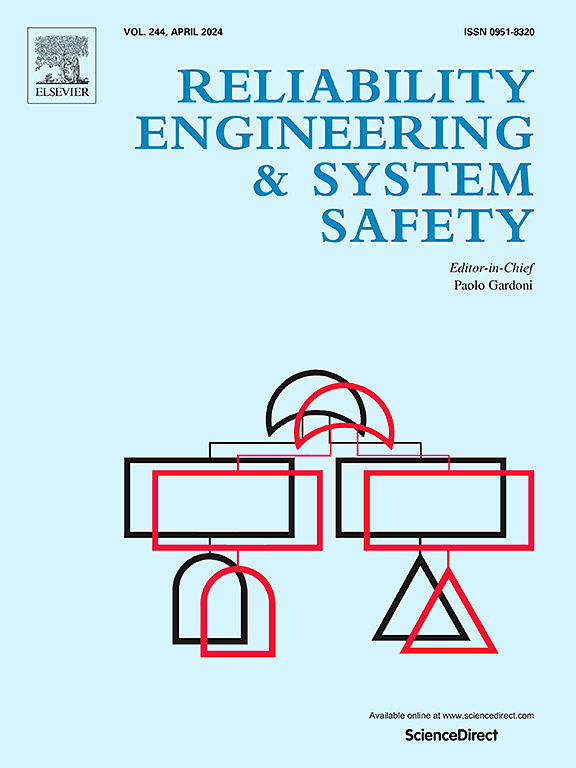Time-dependent system reliability analysis of a high concrete-faced rockfill dam by integrating multi-source monitoring information
IF 9.4
1区 工程技术
Q1 ENGINEERING, INDUSTRIAL
引用次数: 0
Abstract
This paper presents a time-dependent reliability analysis method for concrete-faced rockfill dams (CFRDs) by integrating multiple failure modes and multi-source monitoring data via Bayesian networks. Initially, two sub-Bayesian networks are constructed to fuse dam parameters, two related failure modes, and three types of monitoring data. Subsequently, the prior failure probabilities of the dam system for each period are calculated through the time-variant response relationships among network nodes. These response relationships introduce a time-variant term to quantify the effects of water level and creep. Finally, various types of monitoring data are utilized to update parameter distribution, resulting in the posterior failure probabilities. The proposed method is applied to 233-meter-high Shuibuya CFRD. The results indicate that Bayesian networks offer a more comprehensive and reliable assessment. Water level induces periodic variations in system reliability, while creep drives the long-term trend by increasing slabs' failure probabilities. The failure probabilities of dam system increase over the initial ten years and stabilize as creep converges. The slabs’ failure probabilities vary from location. Seepage failure probability is primarily dominated by the most critical slab. Utilizing multi-source monitoring data can reduce uncertainties, mitigate the interference of localized abnormal data, and identify potential failure locations. This approach supports enhanced dam safety management.
综合多源监测信息的高面板堆石坝系统时变可靠性分析
提出了一种基于贝叶斯网络综合多种破坏模式和多源监测数据的面板堆石坝时变可靠度分析方法。首先,构建了两个子贝叶斯网络来融合大坝参数、两种相关的破坏模式和三种监测数据。然后,通过网络节点间的时变响应关系,计算出各时段大坝系统的先验失效概率。这些响应关系引入了一个时变术语来量化水位和蠕变的影响。最后利用各类监测数据更新参数分布,得到后验失效概率。将该方法应用于233米高水布垭CFRD。结果表明,贝叶斯网络提供了一个更全面和可靠的评估。水位引起系统可靠性的周期性变化,而蠕变通过增加板的破坏概率来驱动长期趋势。坝系的破坏概率在前10年逐渐增大,并随着蠕变收敛趋于稳定。楼板的破坏概率因位置而异。渗流破坏概率主要由最临界板控制。利用多源监测数据可以减少不确定性,减轻局部异常数据的干扰,识别潜在的故障位置。这种方法有助于加强大坝安全管理。
本文章由计算机程序翻译,如有差异,请以英文原文为准。
求助全文
约1分钟内获得全文
求助全文
来源期刊

Reliability Engineering & System Safety
管理科学-工程:工业
CiteScore
15.20
自引率
39.50%
发文量
621
审稿时长
67 days
期刊介绍:
Elsevier publishes Reliability Engineering & System Safety in association with the European Safety and Reliability Association and the Safety Engineering and Risk Analysis Division. The international journal is devoted to developing and applying methods to enhance the safety and reliability of complex technological systems, like nuclear power plants, chemical plants, hazardous waste facilities, space systems, offshore and maritime systems, transportation systems, constructed infrastructure, and manufacturing plants. The journal normally publishes only articles that involve the analysis of substantive problems related to the reliability of complex systems or present techniques and/or theoretical results that have a discernable relationship to the solution of such problems. An important aim is to balance academic material and practical applications.
 求助内容:
求助内容: 应助结果提醒方式:
应助结果提醒方式:


